�

�
Jay Nadelson's Cooper T43 Formula 2 Racecar
� � Owner: Jay Nadelson� City: Millburn / Short Hills, New Jersey
� Model: Cooper T43 ("F2/19/57", circa 1957)
� Engine: Climax FPF 1475cc (twin cam)
� Race prepared by: Tivvy's Autocraft �
�
Cooper T43 Number 19
��
The Cooper T43 was the 1957 (MarkII) version of Cooper's original Formula 2 model. The 1956 �
(MarkI) version was called T41, and the 1958 (MarkIII) version was called T45. Serial numbers �
for the T43 cars always start "F2" and end "57". The number between prefix and suffix is the �
car's serial number, 1 through 31.�
�
The appendix of Cooper Cars by Doug Nye contains a list of Cooper T43 cars, sorted �
by serial numbers, with their respective purchaser names and information about their engines. �
Doug Nye composed his list by transcribing a handwritten ledger, which on at least one occasion �
he has described as "a work of convenient fiction." Indisputedly, and as the ledger has it, �
most T43 cars were built with Climax twin-cam FPF engines. The ledger seems to show that �
five cars (including Cooper's "school" cars) were built with Climax single-cam FWA (nominally �
1097cc) engines, and four cars were built with Climax FWB (nominally 1460cc) engines. Only �
exactly one car - F2/19/57 - is listed as having been built with a Climax single-cam FWE engine. �
The FWE was a single-cam version of the Climax engine, nominally displacing 1216cc, that was �
used in the Lotus Elite. The Lotus Elite didn't enter serial production until 1958, and a very �
reasonable question has been raised as to whether the FWE engine was even available for this �
Cooper as early as 1957. �
�
F2/19/57 was originally purchased and raced by an enthusiastic club racer and former WWII RAF �
fighter pilot named "Dickie" Stoop. In addition to club events, Stoop entered a couple full-fledged �
Formula 2 races. The records of the Levant Cup race at Goodwood on April 7, 1958 show that Stoop �
drove a Climax FWB powered Cooper T43 to finish last, in ninth place. Stoop's T43 was the only �
single-cam car participating, and it it was two laps down by the end of this fifteen lap race. The �
race was won by Jack Brabham, followed by Graham Hill in second place. The records of the Maidstone �
and Mid-Kent Formula 2 race of May 10, 1958 show Dickie Stoop driving a Climax FWB powered Cooper �
T43 to finish last, in third place. Again, Stoop's car was the only single-cam car participating, �
and this time he wasn't lapped. The race was won by Bruce McLaren. So, we get the picture that �
Dickie Stoop aspired to race in Formula 2 and quickly learned that two camshafts would be required �
to be competitive. Dickie Stoop only used the single-cam Cooper for a short time before buying a �
Climax FPF powered Cooper T45 (F2/11/58).�
�
At some point, F2/19/57's original engine was removed and replaced with a Climax FPF twin camshaft �
engine, as shown below. We don't have any information about when the engine swap was completed.�
�
Dickie Stoop sold F2/19/57 to Bill de Selincourt, who entered it in at least one Formula 2 race �
(the Maidstone and Mid-Kent race of 1959). It passed to Sir Nicholas Frederick Hedworth Williamson 11th Bt., �
who drove it in hillclimbs. After that, its history is unclear for about thirty years. �
American enthusiast Phil Bostwick imported F2/19/57 from England to U.S.A., owned it for several years, �
and drove it occasionally in Vintage Sports Car Club of America (VSCCA) events. Incidentally, Phil was �
one of the five founding members of The Cooper Car Club. In 2001, Phil sold F2-19-57 to Jay Nadelson, �
who currently owns and races it.�
�
�
Please support the sponsoring companies who make www.BritishRaceCar.com possible, including:
� �
 �
�
�
�
�
�
Features and Specifications
�| Engine: | �Coventry Climax FPF (dual cam, five bearing, 1475cc) engine.�
Dual Weber 45DCOE carburetors.�
Lucas breaker point ignition. �
MSD rev limiter.�
Dry sump lubrication (the oil tank is mounted behind the radiator). | �
| Cooling: | �copper and brass radiator, plus a very small oil cooler. | �
| Exhaust: | �custom tri-Y headers, with SuperTrapp diffuser discs. | �
| Transaxle: | �Hewland Mark IX | �
| Front Susp.: | �transverse leaf spring, with radius rod in lieu of "curly link". Koni shock absorbers. | �
| Rear Susp.: | �transverse leaf spring, with "curly link". Koni shock absorbers. | �
| Brakes: | �(master) dual Girling master cylinders with bias bar. � (front) Girling 10" x 1.75" twin leading shoe drum brakes. � (rear) Girling 10" x 1.75" twin leading shoe drum brakes. | �
| Wheels/Tires: | �Cooper magnesium 8-spoke wheels.�
Dunlop Racing tires. � (CR48/R6 tread pattern, 4.50L-15 tires on front. CR65/R7 tread pattern, 5.50L-15 tires on rear). | �
| Electrical: | �small lead/acid battery, mounted just forward of the engine. | �
| Instruments: | �(left to right)�
Smiths coolant temperature gauge (90-230F), �
Smiths oil pressure gauge (0-100psi),�
Smiths Chronometric tachometer (500-9000rpm), �
Smiths oil temperature gauge (40-140C),�
Smiths fuel pressure gauge (0-10psi). | �
| Fuel System: | �Fuel Safe fuel cell in the lefthand pannier position.�
(The original saddle tank is present but not used, and the original right-hand-side pannier�
tank has been removed to make room for a fire extinguishing system.) | �
| Safety Eqpmt: | �centralized fire extinguisher system.�
TRS (Total Restraint System) six point, cam-lock safety harness. | �
| Weight: | �~811 dry. | �
| Racing Class: | �Formula 2 | �
Engine Installation
��
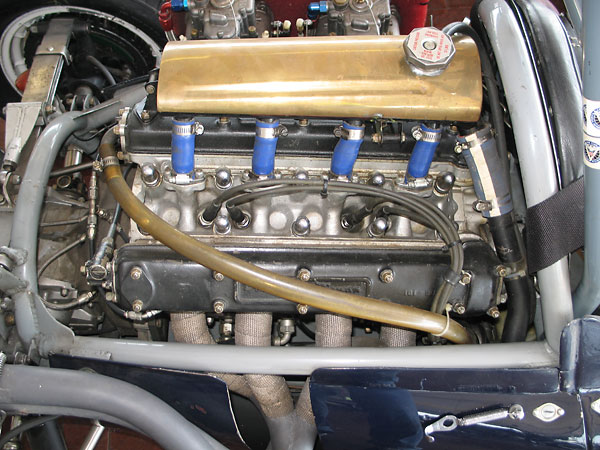
�
Approximately two-thirds of Cooper T43 race cars were originally built with Coventry Climax FPF dual cam
�
engines like this one. However, this particular car (serial number "F2-19-57") was originally built with a
�
single camshaft engine. At some point the car has been upgraded. The FPF engine features a five main
�
bearing crankshaft and a dry sump. With 81.2mm bore and 71.1mm stroke, it displaces 1475cc.
�
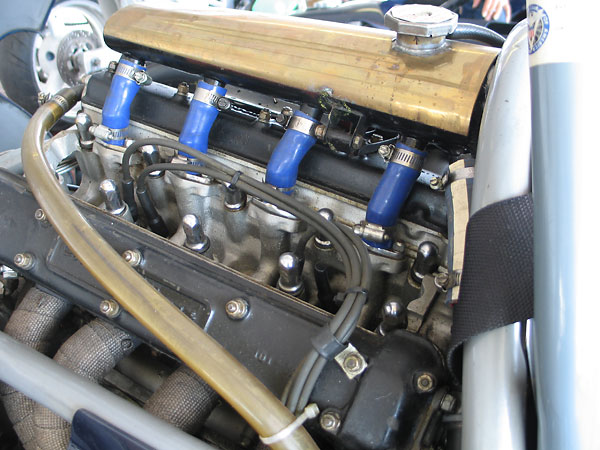
�
Characteristically Cooper: a brass coolant header tank directly feeds the cylinder head.
�
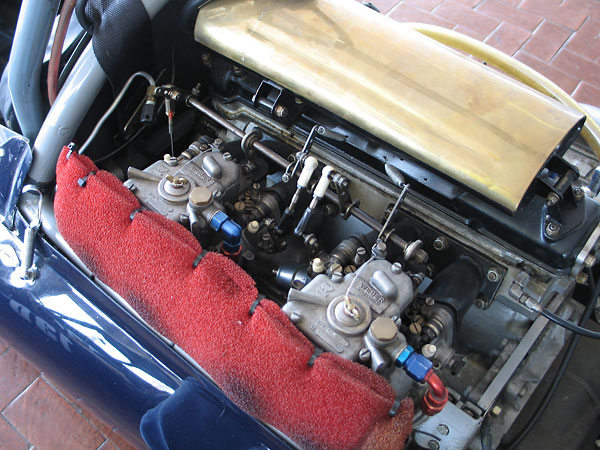
�
FPF engines were originally supplied with special sand-cast, twin-choke S.U. "DU6" (1.75" bore) carburetors.
�
(Jay has a set of these rare carburetors, but he prefers racing with Webers.)
�

�
Dual Weber 45DCOE carburetors installed on custom fabricated tubular steel manifolds.
�
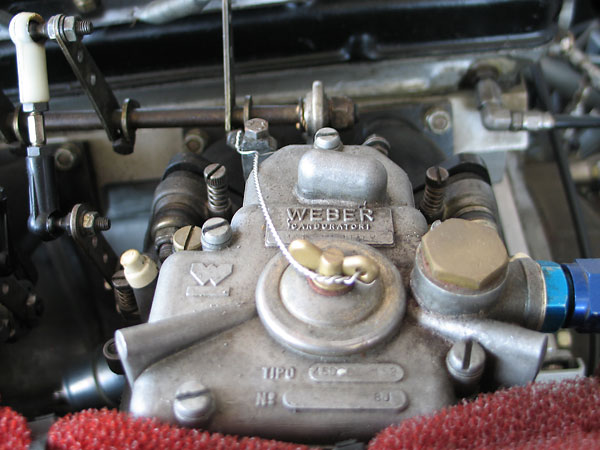
�
Although Coventry Climax engineers had a strong preference for S.U. carbs, many of their
�
customers strongly preferred Webers, notably including Stirling Moss and his mechanics.
�
(Alf Francis installed dual 42DCOE Webers on Stirling Moss' FPF-powered Cooper T43.)
�

�
Custom Tri-Y (4 into 2 into 1) headers, terminated with SuperTrapp diffuser discs.
�
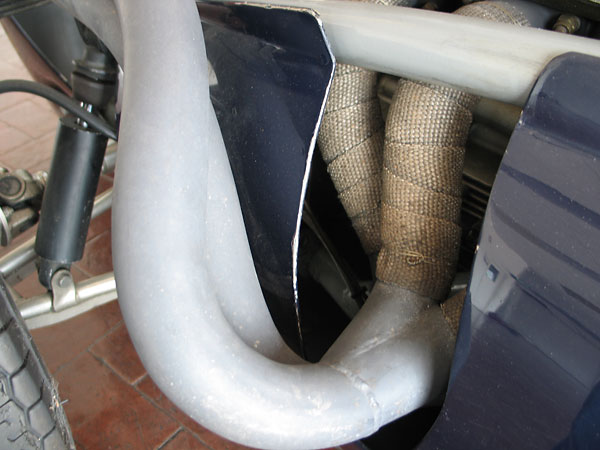
�
Header wrap helps to keep heat inside the exhaust headers. A twist of steel wire holds the wrap tight.
�
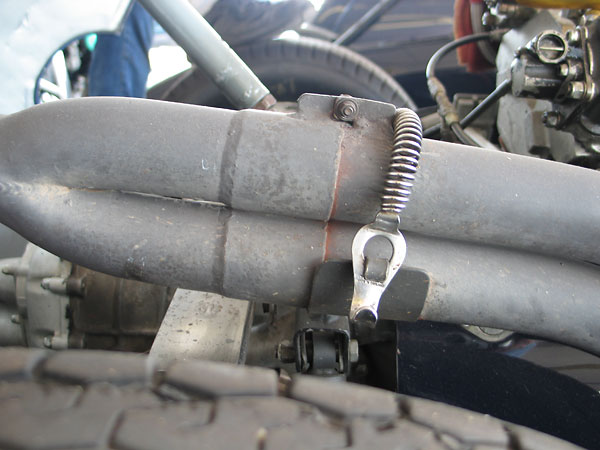
�
A slip coupling and a spring-loaded mount should help the headers resist cracking.
�

�
Another view of the muffler bracket, and also the roll-over hoop brace lower attachment point.
�
(The brace and the roll hoop itself are modern additions, required for vintage racing.)
�
�
Enjoying this article? www.BritishRaceCar.com is partially funded through generous support from readers like you!
�
To contribute to our operating budget, please click here and follow the instructions.
�
(Suggested contribution is twenty bucks per year. Feel free to give more!)�
Frame, Transaxle, and Rear Suspension
��
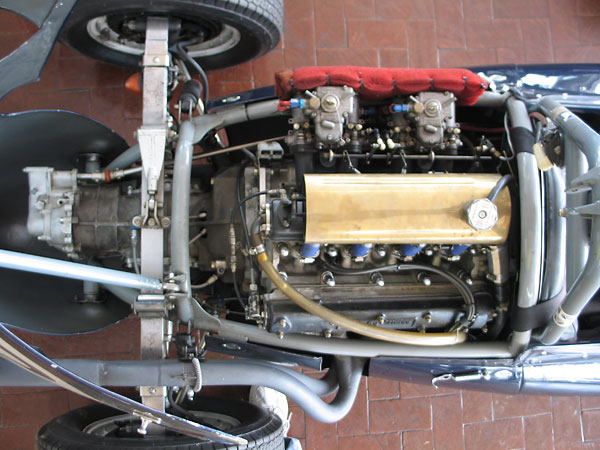
�
In some areas, Cooper reduced weight obsessively. However, with curved tubes and almost no triangulation,
�
the T43 has a very inefficient frame design. Cooper tried to compensate by using relatively large tubing.
�
(Most tubes are 1.5" x 14 or 16 gage, compared to 1" x 18 gage tubes on Lotus and BRM frames of the era.)
�
Even the most ardent Cooper enthusiast wouldn't claim Cooper frames were stiff. In 1960, Tony Rudd of BRM
�
bought a Cooper T45 and measured it. According to Rudd, the Cooper T45 frame weighed 101 pounds, yet
�
demonstrated a torsional rigidity of just 365 foot pounds per degree over its wheelbase. For comparison,
�
BRM's new frame weighed 82 pounds and provided a torsional rigidity of 2020 foot pounds per degree.
�
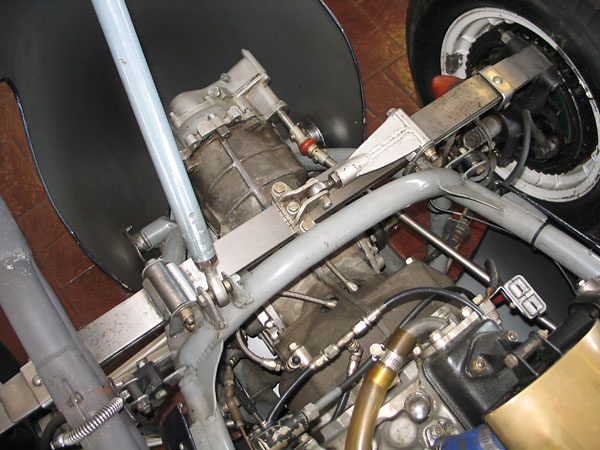
�
One of the most important modifications this car has seen is replacement of the original Citroen-ERSA
�
4-speed gearbox with a Hewland. Back in the day, gearbox failures particularly plagued Formula Two
�
Coopers, causing a very high proportion of Cooper's DNF's. Jay owns an original ERSA transmission,
�
but it's not used anymore because it's fragile and quite expensive to repair. Englishman Mike Hewland
�
started modifying Volkswagen transaxles for racing use in 1957. Many Coopers have been converted.
�
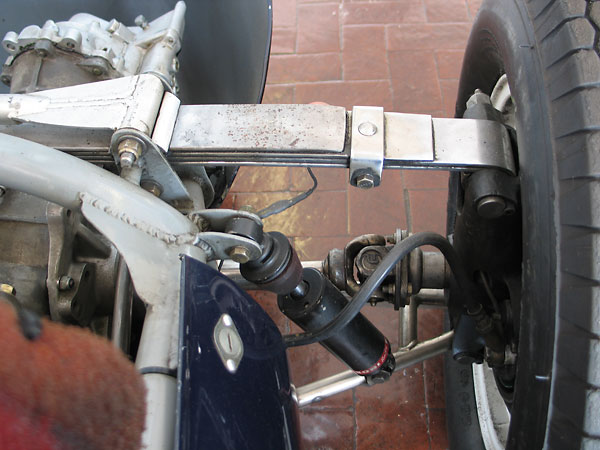
�
As with the front suspension, leafsprings are called on to locate the upper ends of the hub carriers in three
�
dimensions. The arc of the spring changes with bump and roll. When braking or under the reaction force of
�
accelerating forward, leafsprings are twisted. The Rob Walker / Stirling Moss team believed the leafsprings
�
needed help, so race mechanic Alf Francis supplemented that team's T43's with long upper radius rods.
�
(Note: all four original Armstrong shock absorbers on this car have been replaced with KONI shocks.)
�
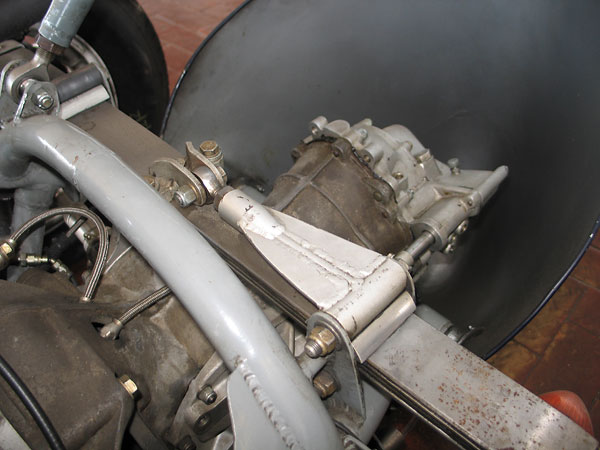
�
The transverse leafspring isn't bolted tightly to the frame; it flexs and slides against widely spaced rollers.
�
This T43 originally came with a "curly leaf" spring¹, to center the transverse leafspring and increase roll stiffness.
�
However, Cooper reportedly found that their curly leaf springs fatigued, changing roll stiffness characteristics
�
over time. On the rear suspension of the T45 model, Cooper replaced the curly leaf with a short radius rod.
�
Evidently, at some point this T43 has been retrofitted with a T45 radius rod for more precise lateral location.
�
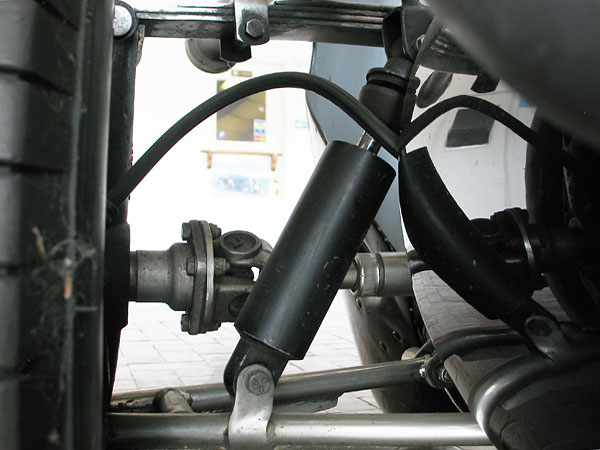
�
Lower suspension brackets on the frame were rather close together. The shock absorber mounting bracket
�
on the wishbone is cantilevered off the front arm of the wishbone, weakly supported. On the T45 model,
�
Cooper would spread the wishbone arms further apart, and move the shock absorber mount to the bridge
�
between front and rear arms of the wishbone, thus making the design substantially more stable and robust.
�

�
Although the T45 rear suspension featured many improvements, it still didn't include upper wishbones.
�
By July 1958, the factory race team was installing upper wishbones on all their cars, leaving leafsprings
�
to function simply as springs, but that upgrade didn't appear in serial production until 1959's T51 model.
�
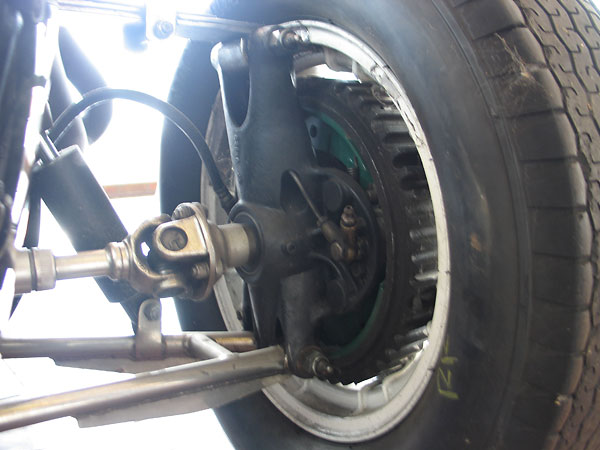
�
Cooper's proprietary cast magnesium rear uprights.
�
�
Front Suspension
��

�
The Cooper T43 front suspension is an improved variant of the Fiat Topolino suspension, as used on Cooper's
�
first 500cc race cars. A transverse leafspring locates the upper ends of the uprights (a.k.a. hub carriers) in
�
three dimensions. Cooper mounted the leafspring on rollers and used a dual purpose curly leaf spring to
�
center the leafspring and provide roll stiffness. This approach proved more than adequate for Formula Three,
�
but didn't stay in use long after Cooper began racing in faster classes. The T45 model would instead be
�
equipped with dual wishbone front suspensions featuring coilover shock absorbers and anti-sway bars.
�

�
The uprights on this particular T43 look similar to the "500cc" uprights of years before², but they're much
�
stronger and more precisely made, with their main section milled from billet steel instead of fabricated from
�
folded flat stock. (We haven't confirmed whether these uprights are original to the T43, or a later upgrade.)
�
Note that drum brakes were standard equipment on the T43, with disc brakes available as an option.
�
Reportedly, some drivers preferred the feel of the drum brakes plus they were much less expensive.
�
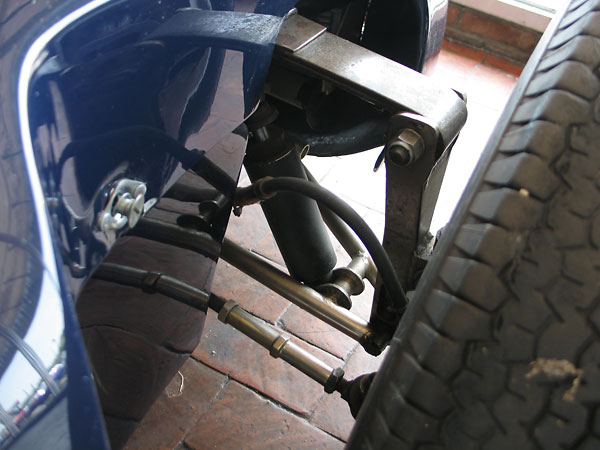
�
The steering rack is mounted low and behind the the front wheels. This particular T43 has been equipped
�
with reverse-threaded links that make adjustment of toe-in quick and easy. As originally built, the T43 had
�
no easily adjustable suspension characteristics. Toe-in, caster, camber, ride height, roll stiffness, etc., all
�
required partial disassembly. Most adjustments required shims or part substitutions. With introduction of
�
dual wishbones on the T45, Cooper made an important innovation: they terminated their wishbones with
�
Heim joints! Racers soon found that subtle suspension adjustments could dramatically affect handling.
�
�
Interior
��

�
Cooper steering wheel.
�

�
"New Brakes!" Brake pads need to be properly conditioned - bedded-in - before they're ready for racing.
�
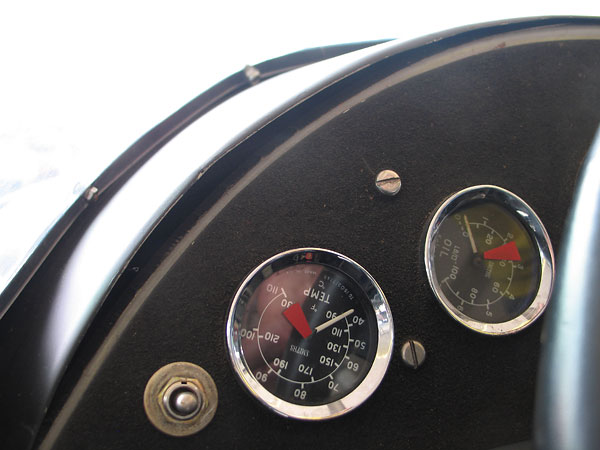
�
Smiths coolant temperature gauge (90-230F), and Smiths oil pressure gauge (0-100psi).
�
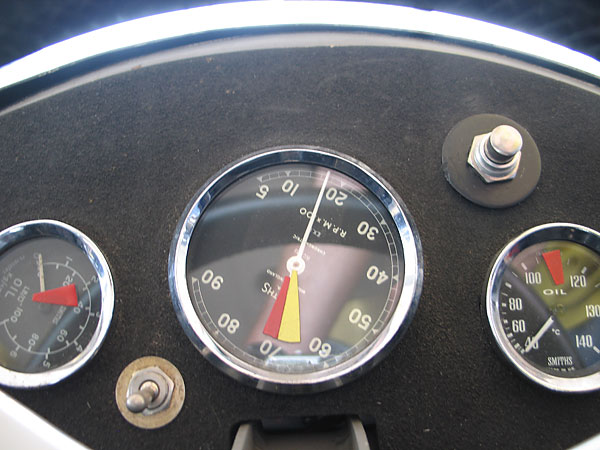
�
Smiths Chronometric tachometer (500-9000rpm).
�
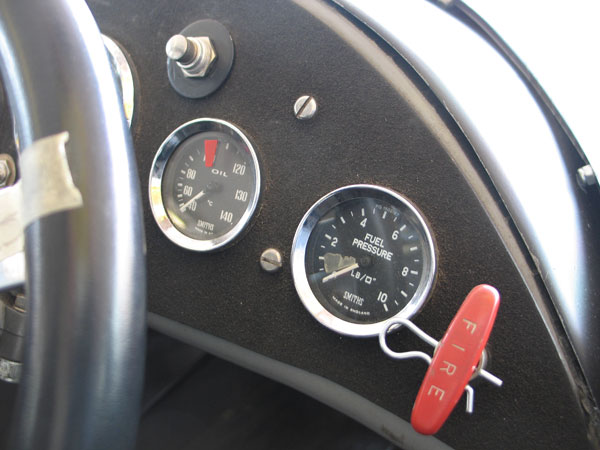
�
Smiths oil temperature gauge (40-140C), and Smiths fuel pressure gauge (0-10psi).
�

�
Few formula cars have such roomy and comfortable cockpits.
�
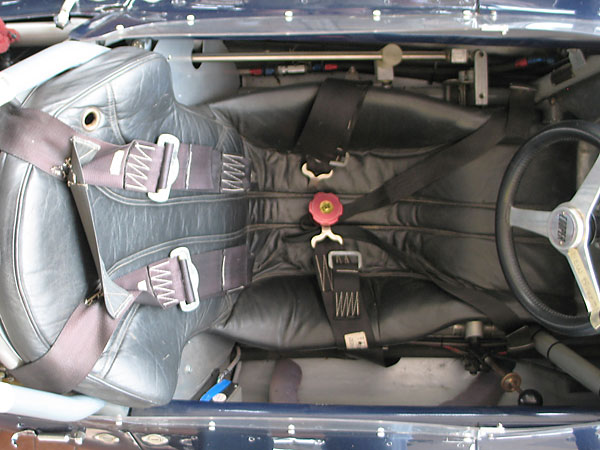
�
TRS (Total Restraint System) Motorsport Equipment six point, cam-lock safety harness.
�
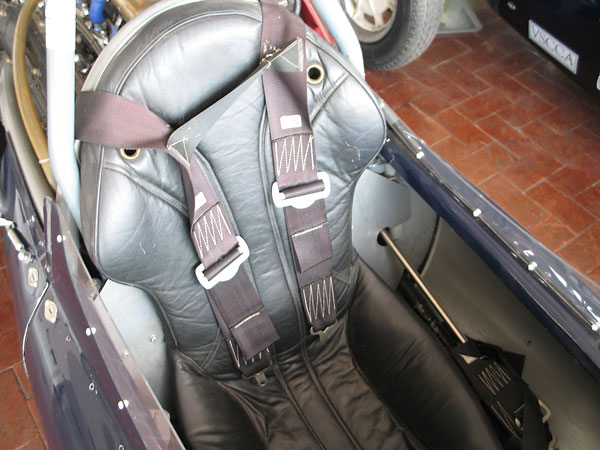
�
Comfortable backrest.
�
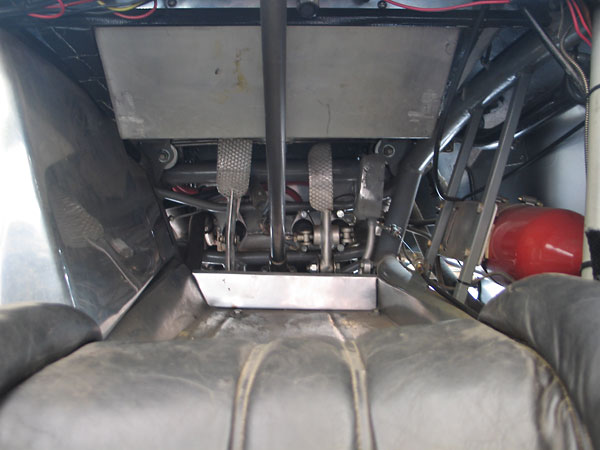
�
The T43 accomodated dual side-mounted "pannier" fuel tanks (12.5 gallon each) plus a 5.5 gallon saddle
�
tank over the center. Actual tank requirements varied with racing situations. Grand Prix races were the
�
worst case: 500km long and required to use methanol (in 1957). Smaller, lighter tank combinations were
�
used for sprint races. The saddle tank shown here is no longer used, and the original righthand pannier
�
tank has been removed to make room for a fire suppression system.
�

�
A custom Fuel Safe fuel cell has been installed in place of the original lefthand fuel tank.
�
Cooper Car Company chassis number plate is riveted to the frame, next to the fuel cell.
�
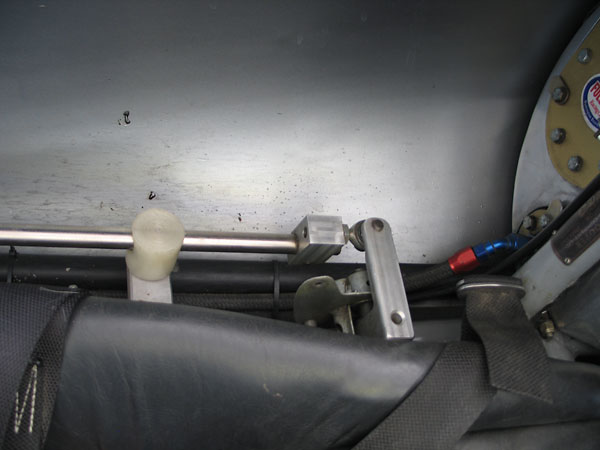
�
Although the original Citroen-ERSA gearbox has been replaced with a Hewland, and a new shifter linkage
�
has been fabricated, the basic shifter design bears some similarity to original. The shift lever is at
�
right, and a linkage passes under the seat, then runs rearward along the left side of the cockpit.
�
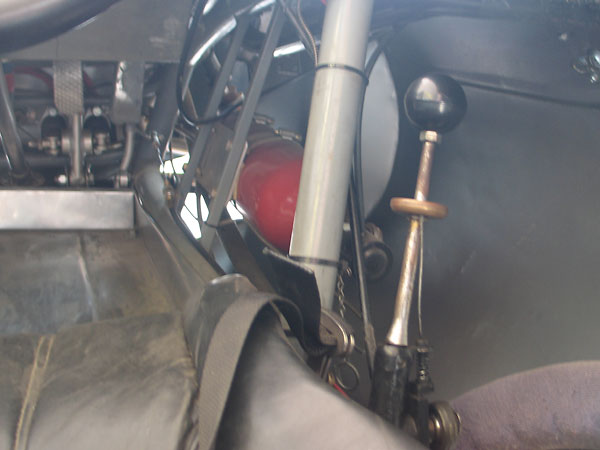
�
Shifter lever and fire extinguisher.
�
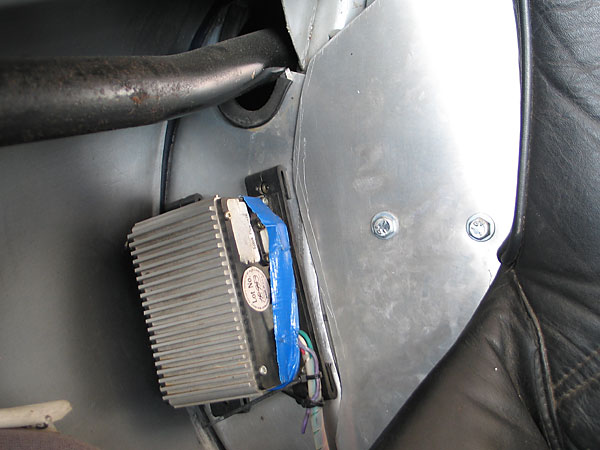
�
MSD Soft-Touch rev limiter. The cut-off speed is adjusted by changing plug-in "chips".
�

�
Roll hoop, headrest, shoulder harness, and emergency engine kill switch:
�
valuable safety features that are necessary to keep these cars racing.
�
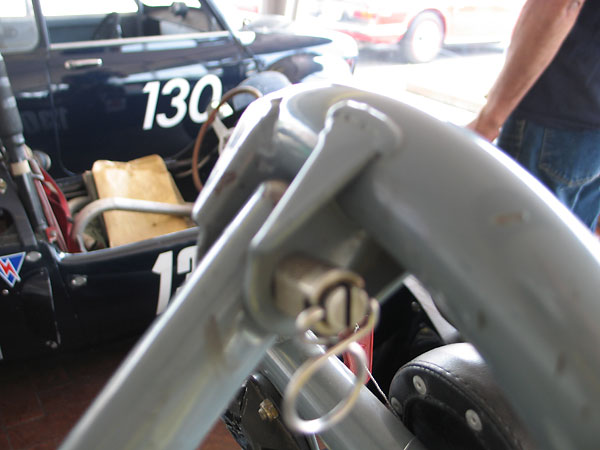
�
The roll hoop brace can be temporarily disconnected and pivoted rearward for engine access.
�
�
Exterior
��
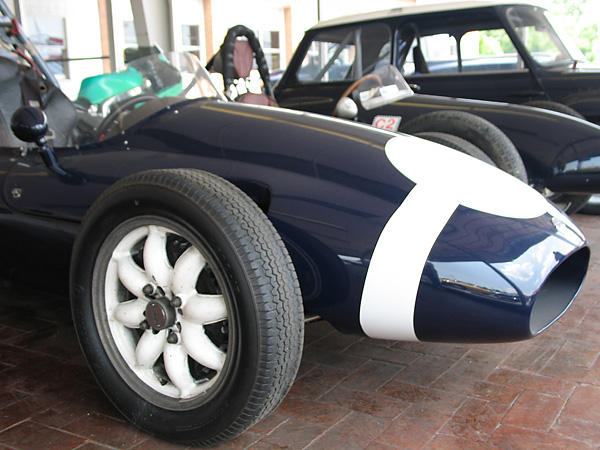
�
Dark blue accentuated by a white band is a popular scheme for Cooper Formula Two race cars. This was
�
the color scheme used by the famous Rob Walker Racing Team, for whom Stirling Moss drove.
�
Mr. Walker was Scottish, and blue and white are the national colors of Scotland.
�
Incidentally, he was also heir to the Johnnie Walker scotch whisky fortune.
�
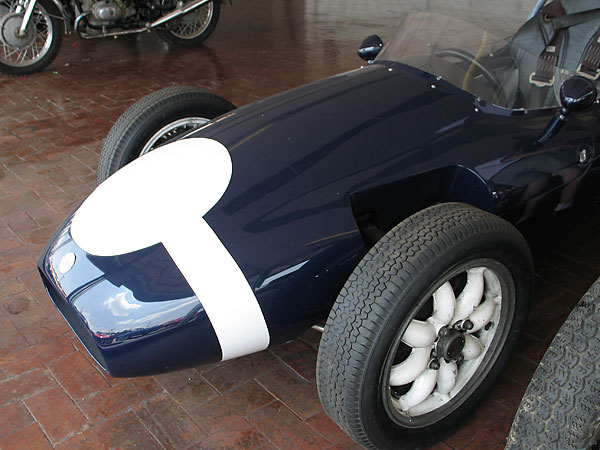
�
When designing Cooper's first Formula Two car, the T41 model of 1956, Owen Maddock centered the radiator
�
opening in front of the radiator. With the T43 model, the nose was recontoured to sit lower in front.
�
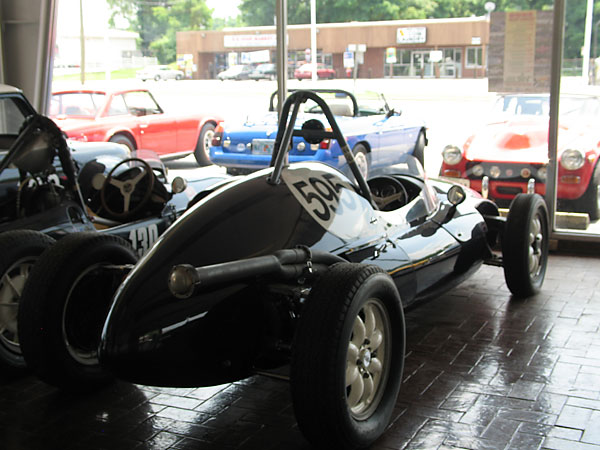
�
The radiator is mounted to the nose bodywork, and it tilts forward with the nose cone for maintenance.
�
When the car is in motion, after air flows through the radiator it exits through front suspension openings.
�

�
Raydyot (or replica) mirror, painted body color.
�
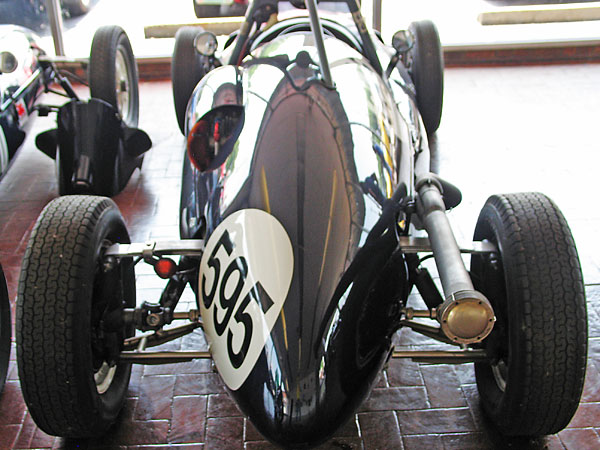
�
SuperTrapp diffuser discs provide just a little bit of sound muffling effect to the exhaust.
�
This is particularly required for racing at Lime Rock, where sound rules are strictly enforced.
�
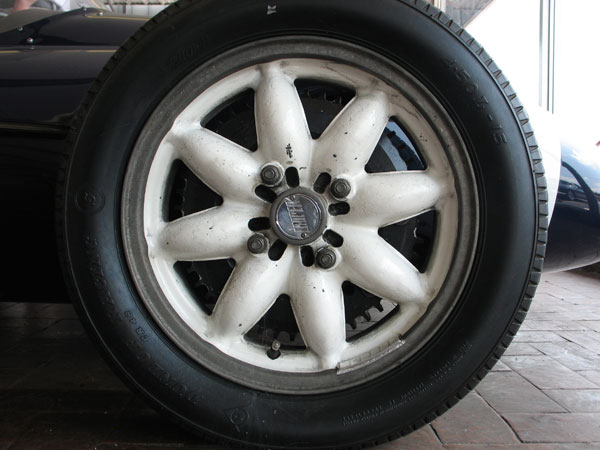
�
Custom lightweight alloy wheels had been a Cooper feature from the company's earliest days. Cooper's first
�
wheels were aluminum, but most original Cooper race wheels were cast in magnesium alloy. Owen Maddock
�
designed Cooper's distinctive magnesium 8-spoke wheels for the Bob-tail MkII model of 1956. In a way, the
�
8-spoke design was a big departure; earlier Cooper wheel designs featured integral brake drums. The design
�
accomodated disc brakes and high cornering force, but the big competitive advantage was their light weight.
�
They would become a Cooper trademark before evolving into the ubiquitous Minilite design of the sixties.
�
�
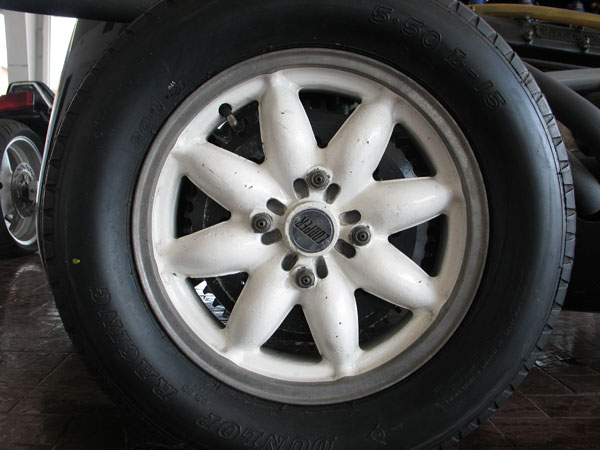
�
For Grand Prix racing, Cooper's stud-mounted wheels represented a daring gamble. They were clearly lighter
�
than old-fashioned wire-spoked wheels, but wheel changes would be slower. Had tire compounds improved so
�
much that a car might last an entire race without changing tires? Ferrari lost the bet. Jay Nadelson's T43
�
is wearing Dunlop CR48 (R6 tread pattern) 4.50L-15 front and CR65 (R7 tread pattern) 5.50L-15 rear tires.
�
| Footnotes: | |||||||
| (1) | �
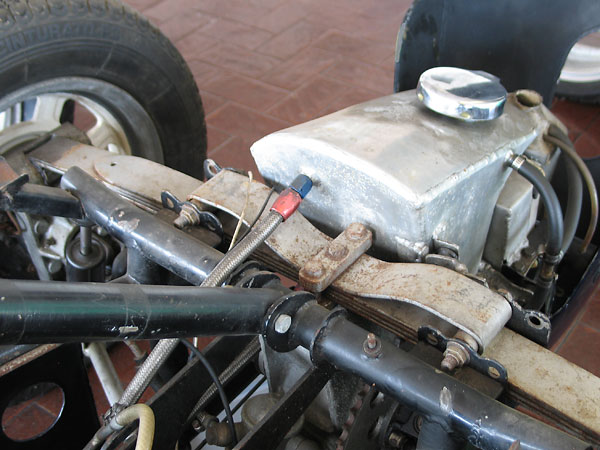 � For reference, this photo shows a typical example of a Cooper "curly leaf" spring. � | ||||||
| (2) | �
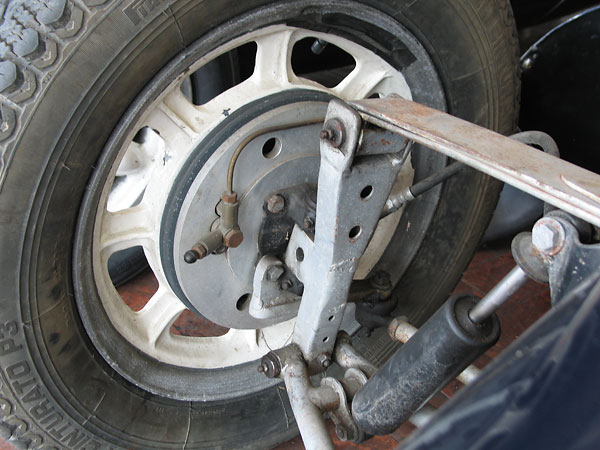 � For reference, this photo shows a typical example of a Cooper 500cc car's fabricated front upright. � � Note: both of these photos show Tivvy Shenton's Formula 3 Cooper. � | ||||||
�
All photos shown here are from June 2009, when BritishRaceCar.com visited Tivvy's Autocraft in Danville Virginia.
�
All photos by Curtis Jacobson for www.BritishRaceCar.com, copyright 2010. All rights reserved.
�
| If you liked this article, you'll probably also enjoy these: | �|||||
 | �
Syd Silverman '59 Lister Jag (Costin) | �
 | �
Marcus Jones '60 Lotus 18 Junior | �
 | �
Tom Grudovich '60 Lola Sports Mk1 | �
| You're invited to discuss anything you've seen here on The British Racecar Motorsports Forum! | �|||||
�
Notice: all the articles and almost all the photos on BritishRacecar.com are by Curtis Jacobson.
�
(Photos that aren't by Curtis are explicitly credited.) Reproduction without prior written permission is prohibited.
�
Contact us to purchase images or reproduction permission. Higher resolution images are optionally available.
�

 �
�
